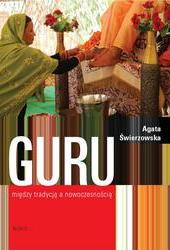
Agata Świerzowska, Guru. Between the Tradition and Present Day [Guru. Między tradycją a współczesnością], Nomos, Krakow 2013.
The aim of the discussion presented in this book is to present the guru in a comparative perspective – tradition vs. modernity – as well as to spotlight some analysis carried out on five contemporary spiritual leaders, in order to illustrate the key features of the phenomenon. In India, although the title "guru" has been bestowed upon a variety of individuals thereby indicating their unique position and role, the term most often appears in a religious or spiritual context. However, it was far more widely understood than in the West. A guru is not exclusively a teacher, a guide , a master or a spiritual leader. All of these competencies are derived from the most essential aspect - the guru is above all a person who through his own self-discipline and perseverance has recognised his own nature, discovered his own self, and thus come to understand the nature of reality. It is through this experience that the guru can lead others and show them the way which he himself has walked. The knowledge held by a guru and given to his disciples has, primarily, soteriological value – it is jnana, gnosis, and therefore knowledge that brings liberation. This is how "guru" is defined in this study – as a person who, according to his own judgment and the conviction of his disciples and followers, has discovered his own self, and thus attained a transcendental reality, has realised his identity with that reality, and thus gained the knowledge he both desires and is able to pass on to others.
All the people discussed in detail in the second part of the book fulfil two important criteria. Firstly, Paramahansa Yogananda, Anandamayi Ma, Mata Amritanandamayi Devi, Adi Da Samraj, and Jiddu Krishnamurti in accordance with their convictions and the judgment of their students have come to know the divine nature of their self and, consequently, reality as a whole. Secondly, every guru mentioned here has acted with the aim of handing down his knowledge, treating this as both a duty and a mission, and used a variety of means to achieve this end. In the case of the five gurus mentioned above, the discovery of knowledge concerning their true nature brought about a radical change in their condition and meant that they, like all the other gurus, stood apart from the flow of everyday life and found themselves – as Victor Turner put it – "betwixt and between": suspended between the reality of the senses and the transcendental. On one hand, they live in the world, subject to the limitations of the flesh, and fulfil their tasks through the body and mind. Yet, at the same time, none of these elements can provide a basis for building identity; none of them defines their place in the social sphere. In my view, it is precisely because of this liminal position, thanks to the ability to move freely in the mundane world, and at the same time with steady access to the supernatural, that the guru can effectively lead his students in the right direction. It is tempting to say that this special state of suspension in which they found themselves to be spiritual guides and was in fact the source of their authority then came to be institutionalised in the form of a guru. It would seem that treating the guru as an institution would not be too extreme, in the normative sense of the term nor would it be inappropriate to view it as a set of norms and values that govern and shape the spiritual dimension of human life.
Key-words: guru, Paramahansa Yogananda, Anandamayi Ma, Mata Amritanandamayi Devi, Adi Da Samraj, Jiddu Krishnamurti

